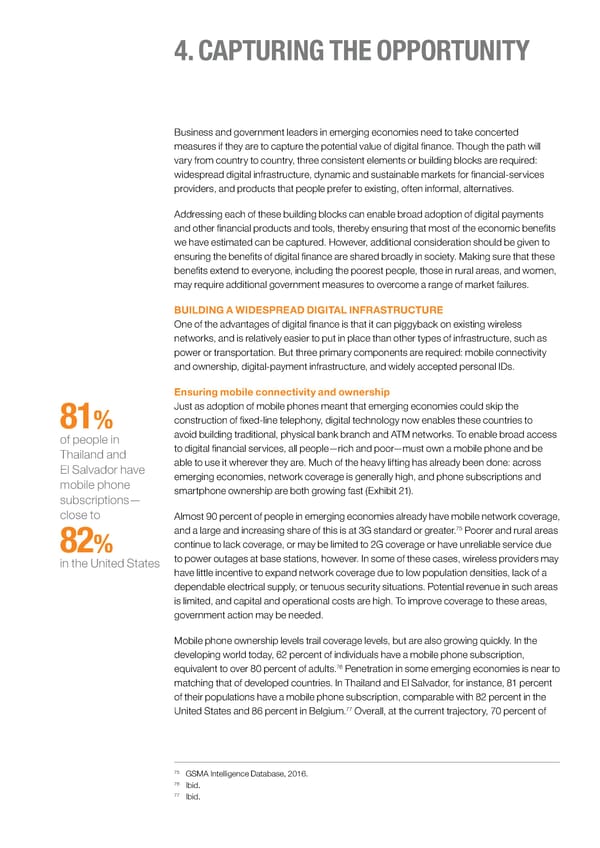4. CAPTURING THE OPPORTUNITY Business and government leaders in emerging economies need to take concerted measures if they are to capture the potential value of digital finance. Though the path will vary from country to country, three consistent elements or building blocks are required: widespread digital infrastructure, dynamic and sustainable markets for financial-services providers, and products that people prefer to existing, often informal, alternatives. Addressing each of these building blocks can enable broad adoption of digital payments and other financial products and tools, thereby ensuring that most of the economic benefits we have estimated can be captured. However, additional consideration should be given to ensuring the benefits of digital finance are shared broadly in society. Making sure that these benefits extend to everyone, including the poorest people, those in rural areas, and women, may require additional government measures to overcome a range of market failures. BUILDING A WIDESPREAD DIGITAL INFRASTRUCTURE One of the advantages of digital finance is that it can piggyback on existing wireless networks, and is relatively easier to put in place than other types of infrastructure, such as power or transportation. But three primary components are required: mobile connectivity and ownership, digital-payment infrastructure, and widely accepted personal IDs. Ensuring mobile connectivity and ownership Just as adoption of mobile phones meant that emerging economies could skip the 81% construction of fixed-line telephony, digital technology now enables these countries to of people in avoid building traditional, physical bank branch and ATM networks. To enable broad access Thailand and to digital financial services, all people—rich and poor—must own a mobile phone and be El Salvador have able to use it wherever they are. Much of the heavy lifting has already been done: across mobile phone emerging economies, network coverage is generally high, and phone subscriptions and subscriptions— smartphone ownership are both growing fast (Exhibit 21). close to Almost 90 percent of people in emerging economies already have mobile network coverage, 75 Poorer and rural areas and a large and increasing share of this is at 3G standard or greater. 82% continue to lack coverage, or may be limited to 2G coverage or have unreliable service due in the United States to power outages at base stations, however. In some of these cases, wireless providers may have little incentive to expand network coverage due to low population densities, lack of a dependable electrical supply, or tenuous security situations. Potential revenue in such areas is limited, and capital and operational costs are high. To improve coverage to these areas, government action may be needed. Mobile phone ownership levels trail coverage levels, but are also growing quickly. In the developing world today, 62 percent of individuals have a mobile phone subscription, 76 Penetration in some emerging economies is near to equivalent to over 80 percent of adults. matching that of developed countries. In Thailand and El Salvador, for instance, 81 percent of their populations have a mobile phone subscription, comparable with 82 percent in the 77 United States and 86 percent in Belgium. Overall, at the current trajectory, 70 percent of 75 GSMA Intelligence Database, 2016. 76 Ibid. 77 Ibid.
 DIGITAL FINANCE FOR ALL Page 71 Page 73
DIGITAL FINANCE FOR ALL Page 71 Page 73